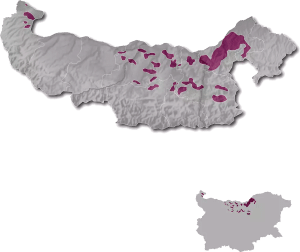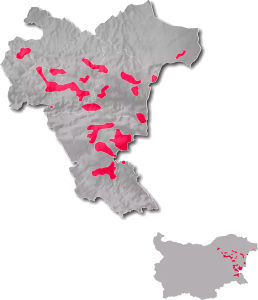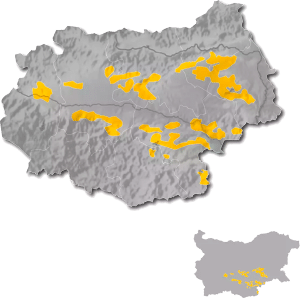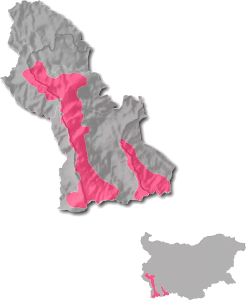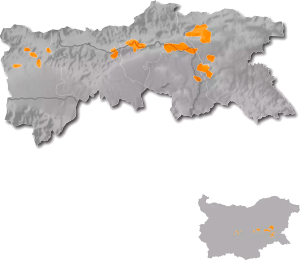North Bulgaria
The Danubian plain
Nestled between the Danube River’s picturesque coastline and the rolling Stara Planina Mountain range lies a fertile expanse of land, gently undulating and caressed by the sun. This is the treasury of Bulgaria’s wine country, where the climate is temperate-continental, gifting the region with warm, sun-drenched summers and brisk, invigorating winters.
Within this favorable environment, a mosaic of grape varieties thrives, each expressing the essence of this remarkable terroir. Here, you’ll find the artistry of Muscat Otonel, the boldness of Cabernet Sauvignon, the velvety allure of Merlot, the elegance of Chardonnay, the charm of Aligote, and the timeless Pamid.
In this timeless valley of Bulgaria, the Gamza tell a story of tradition, heritage, and the irresistible allure of the land. A native grape cherished not only in Bulgaria but also across the Danubian landscapes of Serbia and Hungary, where it is known as Kadarka. Gamza, a robust red variety, finds its truest expression in the vineyards surrounding the historic towns of Vidin and Pleven. These grapes, nurtured by the region’s unique climate, reach their peak ripeness by the end of September, bestowing wines that are fresh, fruity, and imbued with spicy notes, crowned by the unmistakable aroma of ripe raspberries.
Eastern Bulgaria
Black Sea Coast
The captivating Black Sea Coast region encompasses approximately 30% of Bulgaria’s vineyards. The coastal boasts a climate defined by warm summers and mild winters, creating an ideal environment for the cultivation of exquisite white grape varieties. As autumn graces this coastal expanse with its warm, dry embrace, it bestows the gift of time—an extended ripening period that allows grapes to accumulate sugars, crafting the foundation for exceptional white wines.
Within this sun-kissed terroir, you’ll find an array of white grape varieties, each contributing its own unique charm to the region’s viticultural tapestry. Dimyat, Riesling, Muscat Ottonel, Chardonnay, June Blanc, Traminer, and Sauvignon Blanc flourish in these soils, creating a symphony of flavors. The land, with its wide variety of soils, gives its own character to the wines.
One of the region’s timeless treasures is the ancient indigenous grape variety, Dimiat. Revered not only for its versatility but also for its role in crafting delectable dessert wines, Dimiat adds a touch of heritage and allure to Eastern Bulgaria’s winemaking legacy. Here, the vineyards tell a story of tradition, embraced by a climate that nurtures the grapes and a land that holds centuries of viticultural secrets.
But perhaps the jewels of this land are Gergana and Evmolpia.
Southern Bulgaria
Thracian Valley
This is the heart of Bulgaria’s wine country. Deployed in the southern reaches, the еnchanting Upper Thracian Plain is a wine lover’s paradise. Here, a moderate continental climate reigns supreme, creating a harmonious dance of seasons that wine grapes adore. The blessings of nature are bestowed in the form of well-distributed rainfall, nurturing the vineyards and their precious fruit. The soil beneath these vine-laden slopes is a testament to diversity, with cinnamon forest soils, alluvial-deluvial riches, and the distinctive resinous earth.
This fertile canvas, shielded from the harsh northern winds, sets the stage for a captivating symphony of wine, predominantly red and undeniably memorable. Among the vine rows, varieties like Merlot, Mavrud, Ruby, Cabernet Sauvignon, Cabernet Franc, Petit Verdot, and Syrah flourish, painting a portrait of opulence and depth.
But perhaps the shining star of this region is the indigenous Mavrud grape — a varietal cherished for its profound red hue, its bouquet resonating with red fruit notes and spices, and its tannins, which are at once soft and commanding. It’s in this rich, sun-soaked corner of Bulgaria that the vineyards yield wines that are as bold as the land itself, each bottle a testament to the storied tradition and passion of Southern Bulgaria’s winemakers.
Southwestern Bulgaria
Struma River Valley
Nestled in the embrace of mountain chains lies the Struma River Valley, a region that unfurls its enchanting beauty along the Bulgarian part of the Macedonia region. In this timeless corner of Bulgaria, the grapes tell a story of tradition, heritage, and the irresistible allure of the land. Autumn lingers, stretching its golden fingers, while winters bestow their mild, snow-kissed touch. Across this land, the soils are as diverse as the landscape itself, boasting the presence of cinnamon and brown forest soils, alluvial-deluvial gems, and the embracing embrace of mountain meadow soils.
Within these fertile grounds, red grape varieties like Cabernet Sauvignon, Cabernet Franc, and Merlot take root, capturing the essence of this remarkable terroir. The resulting wines bear the signature of the region—a warm, sun-soaked aroma that beckons with a symphony of southern tones. Each sip reveals a fullness of taste and an unparalleled richness, a testament to the land’s generosity.
But it is here, amidst the rolling vineyards of Southwestern Bulgaria, that a true gem resides—the indigenous Broadleaf Melnik grape, also known as Shiroka Melnik. This late-maturing, high-quality grape offers wines with remarkable aging potential. Its vines, nurtured by the Mediterranean climate, yield wines that embody the soul of this captivating region, each bottle a testament to the timeless traditions and dedication of winemakers.
Southeastern Bulgaria
Sakar Hills
Nestled in the southeastern embrace of Bulgaria, Sakar Hills stands as a testament to the harmonious coexistence of two distinct yet captivating worlds. Here, rugged natural beauty collides with the artistry of winemaking, creating a tapestry of wonders waiting to be explored.
Sakar is equally celebrated for its vine-covered slopes that have given birth to some of Bulgaria’s most renowned wines, but also uncharted terroir. The fertile soils, kissed by the sun, nurture grape varieties that have been carefully cultivated for generations. Here, the art of winemaking is woven into the very fabric of the land. It is a former submerged volcanic area; the soil types are very varied with some key indicators suitable for viticulture such as granite, quartz, fossilised sea shells, clay and the presence of iron. The climate of this region is hot and dry, but the subsoil at 60-100 metres has enough water reserves due to the clear distinction of the seasons as well as rainfall in autumn and winter.
As you explore Sakar, you’ll discover vineyards that yield wines as diverse and captivating as the landscape itself. From robust reds that echo the mountains’ strength to crisp whites that capture the purity of the skies, each bottle tells a story of tradition and dedication.
Sakar Mountain invites you to embark on a unique journey—one where you can witness the grandeur of nature and savor the fruits of human ingenuity. Majestic eagles soar through its vast skies, while graceful hawks and falcons make their homes amidst the rugged terrain. Whether you’re a nature enthusiast captivated by the dance of eagles or a wine connoisseur eager to explore new terroirs, Sakar offers an unforgettable experience where these two worlds seamlessly converge.
Find what matters to you
Let us come together to celebrate the harmonious union of wine, food, and good company, for it is in these moments that we forge the most unforgettable experiences.
Join me, and let’s raise a glass to the nature with stubborn winemakers and their wonderful wines.
